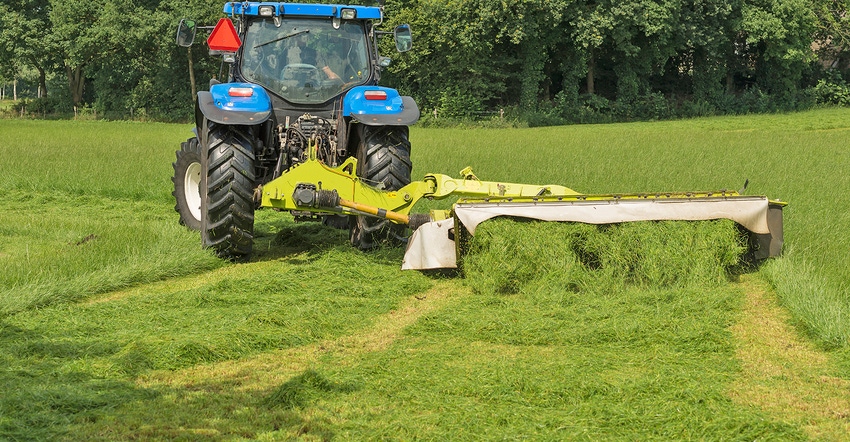April 26, 2018

Hay fields are often considered an “ecological trap” for wildlife, according to Jimmy Doyle, SDSU Extension natural resource management field specialist.
They appear to be high-quality habitat for nesting or feeding due to tall, dense grass and legumes, he says, but they often lead to increased mortality once harvesting is under way. Mortality can be especially high for grassland nesting birds and young mammals that aren’t able to escape harvesting equipment.
“It is difficult to remove all of the negative effects to wildlife, but there are strategies that can mitigate some of these impacts,” he says.
He lists three:
1. Make a simple change to how you harvest alfalfa. Cut hay from the center of a field toward the edges or from one side of the field to the other, rather than circling around towards the center. Often, animals will move out of the path of the swather into the remaining standing vegetation that has not been cut yet. If the hay is being cut in a spiral pattern towards the center of the field, the remaining grass patch becomes increasingly tighter. Animals may be hesitant to flee across the open, cut portion of the field, which can result in higher direct mortality from machinery; animals that do escape may be exposed to higher levels of predation because of the lack of cover. Conversely, if the hay is cut from the center to the edge or one side to the other, animals are able to move out of the path of the cutter towards the edge of the field and hopefully escape. If possible, cutting should progress toward an area of suitable cover to maximize this benefit (e.g. offer escape into standing vegetation vs. cutting towards a previously harvested field). Slowing down in areas where wildlife has been observed, especially hens with broods or does, can offer additional time for animals to get out of the path of machinery. Leaving unharvested strips can offer several benefits by providing escape cover and undisturbed habitat through the nesting season. Of course, this will reduce the hay yield off the field, but unharvested strips will help to catch more snow over the winter, and can be used as standing forage for winter grazing by livestock.
2. Use hay flushing tools. These are added in front of haying machinery to flush hens off nests early enough that they can escape. Although the nest will likely be destroyed, many bird species, including pheasants and ducks, will nest again if the bird survives. These may also be beneficial for young deer fawns, which typically lie motionless to hide from predators. A flushing bar can be designed to work with any type of hay cutting machinery, although some implements may present challenges for mounting. A flushing bar consists of a bar mounted parallel to and several feet in front of the cutting blade. Several short chains hang off the bar that drag along the ground to flush nesting birds. Obviously, care must be taken to ensure that the drag chains are well out of the way of any moving parts they could become entangled with.
Delay harvest when practical. By delaying harvest until the end of the primary nesting season, the majority of nesting activity is complete, minimizing direct mortality to nesting birds. This is not always a desirable option for producers because of the increased maturity of the hay crop. If an operation has a strong wildlife focus, the benefits of increased game bird populations may outweigh the decrease in forage quality. Depending on the intended use of the hay, the decrease in quality may also be offset by an increase in total tonnage of hay by delaying harvest. If harvest cannot be deferred for the entire nesting season, delaying as much as possible will still provide benefits to nesting wildlife.
3. Stop baling hay and let livestock graze it. You can reduce equipment, labor costs and depreciation. The dung from livestock can fertilize the field. Wildlife benefit from a safe nesting period. The dung from livestock increases insect populations, a crucial food source for chicks of many species. Grazing also has the added benefit of increasing the amount of grassland habitat available for wildlife year round.
Many resources are available to assist with adoption of wildlife-friendly haying practices, such as SDSU Extension, South Dakota Game Fish and Parks, U.S. Fish and Wildlife Service, as well as non-profit conservation organizations such as Pheasants Forever and Ducks Unlimited.
Source: SDSU
You May Also Like




